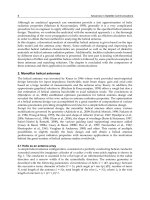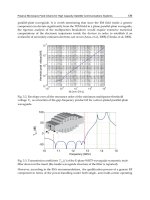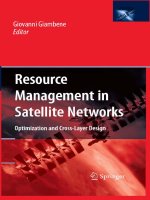Resource Management in Satellite Networks part 2 pot
Bạn đang xem bản rút gọn của tài liệu. Xem và tải ngay bản đầy đủ của tài liệu tại đây (116.06 KB, 10 trang )
Curriculum Vitae
Dr. Giovanni Giambene
Giovanni Giambene was born in Florence, Italy, in 1966. He received the Dr.
Ing. degree in Electronics from the University of Florence, Italy, in 1993 and
the Ph.D. degree in Telecommunications and Informatics from the University
of Florence, Italy, in 1997. From 1994 to 1997, he was with the Electronic En-
gineering Department of the University of Florence, Italy. He was Technical
External Secretary of the European Community COST 227 Action, entitled
“Integrated Space/Terrestrial Mobile Networks”. He also contributed to the
Resource Management activity of the Working Group 3000 within the RACE
Project, called “Satellite Integration in the Future Mobile Network” (SAINT,
RACE 2117). From 1997 to 1998, he was with OTE of the Marconi Group,
Florence, Italy, where he was involved in a GSM development program. In
the same period he also contributed to the COST 252 Action (“Evolution of
Satellite Personal Communications from Second to Future Generation Sys-
tems”) research activities by studying the performance of Packet Reservation
Multiple Access (PRMA) protocols suitable for supporting voice and data
transmissions in low earth orbit mobile satellite systems. In 1999 he joined
the Information Engineering Department of the University of Siena, Italy, first
as research associate and then as assistant professor. He teaches the advanced
course of Telecommunication Networks at the University of Siena. From 1999
to 2003 he participated to the project “Multimedialit`a”, financed by the Ital-
ian National Research Council (CNR). From 2000 to 2003, he contributed to
the activities of the “Personalised Access to Local Information and services
for tOurists” (PALIO) IST Project within the fifth Research Framework of
the European Commission (www.palio.dii.unisi.it). At present, he is involved
in the SatNEx network of excellence of the FP6 programme in the satellite
field, as work package leader of two groups on radio access techniques and
cross-layer air interface design (www.satnex.org). He is also vice-Chair of the
COST 290 Action (www.cost290.org), entitled “Traffic and QoS Management
in Wireless Multimedia Networks” (Wi-QoST).
Contents
Acknowledgements v
Preface vii
Contents xiii
List of Contributors xix
List of Acronyms and Abbreviations xxiii
Part I Resource Management Framework for Satellite
Communications
1 INTRODUCTION TO SATELLITE
COMMUNICATIONS AND RESOURCE
MANAGEMENT 3
1.1 Satellite communications . . . . . . . . . . . . . . . . . . . . . . . . . . . . . . . . 3
1.2 Basic issues in the design of satellite communication systems . 10
1.3 Multiple access techniques . . . . . . . . . . . . . . . . . . . . . . . . . . . . . . . 12
1.4 Radio interfaces considered and scenarios . . . . . . . . . . . . . . . . . . 15
1.4.1 S-UMTS . . . . . . . . . . . . . . . . . . . . . . . . . . . . . . . . . . . . . . . . 15
1.4.2 DVB-S standard . . . . . . . . . . . . . . . . . . . . . . . . . . . . . . . . . 16
1.4.3 DVB-RCS standard . . . . . . . . . . . . . . . . . . . . . . . . . . . . . . . 17
1.4.4 DVB-S2 standard . . . . . . . . . . . . . . . . . . . . . . . . . . . . . . . . 23
1.4.5 Numerical details on the selected scenarios for
performance evaluations . . . . . . . . . . . . . . . . . . . . . . . . . . . 27
1.5 Satellite networks . . . . . . . . . . . . . . . . . . . . . . . . . . . . . . . . . . . . . . 28
1.5.1 SI-SAP interface overview . . . . . . . . . . . . . . . . . . . . . . . . . 31
1.6 Novel approaches for satellite networks . . . . . . . . . . . . . . . . . . . . 34
1.6.1 Horizontal approach . . . . . . . . . . . . . . . . . . . . . . . . . . . . . . 34
xiv Contents
1.6.2 Vertical approach . . . . . . . . . . . . . . . . . . . . . . . . . . . . . . . . 34
1.7 Conclusions 37
References 39
2 ACTIVITY IN SATELLITE RESOURCE
MANAGEMENT 43
2.1 Introduction . . . . . . . . . . . . . . . . . . . . . . . . . . . . . . . . . . . . . . . . . . . 43
2.2 Frequency/time/space resource allocation schemes . . . . . . . . . . 46
2.3 Power allocation and control schemes . . . . . . . . . . . . . . . . . . . . . 50
2.4 CAC and handover algorithms . . . . . . . . . . . . . . . . . . . . . . . . . . . 51
2.4.1 Handover algorithms . . . . . . . . . . . . . . . . . . . . . . . . . . . . . . 53
2.5 RRM modeling and simulation . . . . . . . . . . . . . . . . . . . . . . . . . . . 54
2.6 Related projects in Europe . . . . . . . . . . . . . . . . . . . . . . . . . . . . . . 55
2.6.1 TWISTER: Terrestrial Wireless Infrastructure
integrated with Satellite Telecommunications for
E-Rural applications . . . . . . . . . . . . . . . . . . . . . . . . . . . . . . 56
2.6.2 MAESTRO: Mobile Applications & sErvices based on
Satellite & Terrestrial inteRwOrking . . . . . . . . . . . . . . . . 56
2.6.3 SatNEx: Satellite Network of Excellence . . . . . . . . . . . . . 57
2.6.4 NEWCOM: Network of Excellence in Wireless
COMmunications . . . . . . . . . . . . . . . . . . . . . . . . . . . . . . . . . 57
2.6.5 VIRTUOUS: Virtual Home UMTS on Satellite . . . . . . . 58
2.6.6 COST Actions . . . . . . . . . . . . . . . . . . . . . . . . . . . . . . . . . . . 58
2.6.7 The ISI Initiative . . . . . . . . . . . . . . . . . . . . . . . . . . . . . . . . . 59
2.7 Conclusions 60
References 61
3 QoS REQUIREMENTS FOR MULTIMEDIA
SERVICES 67
3.1 Introduction . . . . . . . . . . . . . . . . . . . . . . . . . . . . . . . . . . . . . . . . . . . 67
3.2 ServicesQoSrequirements 68
3.2.1 Performance requirements for conversational services . . 70
3.2.2 Performance requirements for interactive services . . . . . 73
3.2.3 Performance requirements for streaming services . . . . . 74
3.2.4 Performance requirements for background
services-applications . . . . . . . . . . . . . . . . . . . . . . . . . . . . . . 76
3.3 IPQoSframeworks/models 76
3.4 Broadcast and multicast services . . . . . . . . . . . . . . . . . . . . . . . . . 80
3.4.1 Delayed real-time service over GEO satellite
distribution systems . . . . . . . . . . . . . . . . . . . . . . . . . . . . . . 83
3.4.2 Scenario characterization and results . . . . . . . . . . . . . . . . 85
3.5 ExperimentalresultsonQoS 89
3.6 Conclusions 92
References 93
Contents xv
4 CROSS-LAYER APPROACHES FOR RESOURCE
MANAGEMENT 95
4.1 Introduction . . . . . . . . . . . . . . . . . . . . . . . . . . . . . . . . . . . . . . . . . . . 95
4.2 Literaturesurveyoncross-layermethods 96
4.3 The need of a cross-layer air interface design . . . . . . . . . . . . . . . 102
4.4 Cross-layer design: requirements depending on the satellite
scenario . . . . . . . . . . . . . . . . . . . . . . . . . . . . . . . . . . . . . . . . . . . . . . . 105
4.4.1 Broadband satellite scenario requirements
(DVB-S/S2) 105
4.4.2 Mobile satellite scenario requirements (S-UMTS) . . . . . 108
4.4.3 LEO satellite scenario requirements . . . . . . . . . . . . . . . . . 108
4.5 Conclusions 111
References 113
Part II Cross-Layer Techniques for Satellite-Dependent Layers
5 ACCESS SCHEMES AND PACKET SCHEDULING
TECHNIQUES 119
5.1 Introduction . . . . . . . . . . . . . . . . . . . . . . . . . . . . . . . . . . . . . . . . . . . 119
5.2 Uplink: access schemes . . . . . . . . . . . . . . . . . . . . . . . . . . . . . . . . . . 120
5.2.1 Random access in UMTS and application to S-UMTS . 121
5.2.2 The Packet Reservation Multiple Access (PRMA)
protocol 129
5.2.3 Adopting PRMA-like schemes in S-UMTS . . . . . . . . . . . 131
5.2.4 Stability analysis of access protocols . . . . . . . . . . . . . . . . 132
5.3 Downlink: scheduling techniques . . . . . . . . . . . . . . . . . . . . . . . . . . 134
5.3.1 Survey of scheduling techniques . . . . . . . . . . . . . . . . . . . . 134
5.3.2 Scheduling techniques for HSDPA via satellite . . . . . . . 139
5.3.3 Scheduling techniques for broadcast and multicast
servicesinS-UMTS 152
5.3.4 Packet scheduling with cross-layer approach . . . . . . . . . 164
5.4 Conclusions 170
References 173
6 CALL ADMISSION CONTROL 177
6.1 Introduction to Call Admission Control . . . . . . . . . . . . . . . . . . . 177
6.2 CACandQoSmanagement 179
6.3 CAC algorithms for GEO satellite systems . . . . . . . . . . . . . . . . . 184
6.3.1 CAC schemes for MF-TDMA networks . . . . . . . . . . . . . . 184
6.3.2 CAC schemes for CDMA networks . . . . . . . . . . . . . . . . . 188
6.4 Handover and CAC algorithms for non-GEO satellite systems 189
6.4.1 Intra-satellite handover and CAC schemes . . . . . . . . . . . 191
6.4.2 Inter-satellite handover and CAC schemes . . . . . . . . . . . 194
xvi Contents
6.5 Directions for further research . . . . . . . . . . . . . . . . . . . . . . . . . . . . 199
6.6 Conclusions 200
References 201
7 DYNAMIC BANDWIDTH ALLOCATION 207
7.1 Dynamic bandwidth allocation: problem definition . . . . . . . . . . 207
7.1.1 Survey of allocation approaches . . . . . . . . . . . . . . . . . . . . 209
7.2 DBA schemes for DVB-RCS scenarios . . . . . . . . . . . . . . . . . . . . . 211
7.3 Recent developments on DBA techniques . . . . . . . . . . . . . . . . . . 213
7.3.1 DVB-RCS dynamic channel allocation using
control-theoretic approaches 213
7.3.2 Dynamic bandwidth de-allocation . . . . . . . . . . . . . . . . . . 214
7.3.3 Dynamic bandwidth allocation with cross-layer issues . 214
7.3.4 Joint timeslot optimization and fair dynamic
bandwidth allocation in a system employing adaptive
coding 218
7.3.5 Dynamic bandwidth allocation for handover calls . . . . . 233
7.4 Conclusions 234
References 237
Part III Cross-Layer Techniques for Satellite-Independent Layers
8 RESOURCE MANAGEMENT AND NETWORK LAYER 243
8.1 Introduction . . . . . . . . . . . . . . . . . . . . . . . . . . . . . . . . . . . . . . . . . . . 243
8.2 Overview IPQoSframework 244
8.2.1 Integrated services . . . . . . . . . . . . . . . . . . . . . . . . . . . . . . . . 244
8.2.2 Differentiated services . . . . . . . . . . . . . . . . . . . . . . . . . . . . . 246
8.2.3 Multiprotocol Label Switching (MPLS) . . . . . . . . . . . . . 247
8.3 ResourcemanagementforIPQoS 248
8.3.1 Relative DiffServ by MAC Scheduling . . . . . . . . . . . . . . . 249
8.4 QoS mapping over satellite-independent service access point . 256
8.4.1 Model-based techniques for QoS mapping
andsupport 257
8.4.2 A measurement-based approach for QoS mapping
andsupport 258
8.4.3 Performance evaluation and discussion . . . . . . . . . . . . . . 262
8.5 QoS provisioning for terminals supporting dual network
access - satellite and terrestrial . . . . . . . . . . . . . . . . . . . . . . . . . . . 264
8.6 Switched Ethernet over LEO satellite: implicit cross-layer
design exploiting VLANs . . . . . . . . . . . . . . . . . . . . . . . . . . . . . . . . 270
8.6.1 Protocol harmonization and implicit cross-layer design
viaIEEEVLAN 272
8.6.2 Performance evaluation . . . . . . . . . . . . . . . . . . . . . . . . . . . 273
Contents xvii
8.7 Conclusions 282
References 285
9 RESOURCE MANAGEMENT AND TRANSPORT
LAYER 289
9.1 Introduction . . . . . . . . . . . . . . . . . . . . . . . . . . . . . . . . . . . . . . . . . . . 289
9.2 Overview of TCP over satellite . . . . . . . . . . . . . . . . . . . . . . . . . . . 290
9.2.1 TCP standard mechanisms . . . . . . . . . . . . . . . . . . . . . . . . 291
9.2.2 Criticalities of TCP on satellite links . . . . . . . . . . . . . . . . 292
9.2.3 Survey of proposed solutions . . . . . . . . . . . . . . . . . . . . . . . 293
9.3 Cross-layer interaction between TCP and physical layer . . . . . 294
9.4 Cross-layer interaction between TCP and MAC . . . . . . . . . . . . 298
9.4.1 A novel TCP-driven dynamic resource
allocation scheme . . . . . . . . . . . . . . . . . . . . . . . . . . . . . . . . . 299
9.5 Overview of UDP-based multimedia over satellite . . . . . . . . . . . 305
9.5.1 Cross-layer methods for UDP . . . . . . . . . . . . . . . . . . . . . . 307
9.6 Conclusions 307
References 309
10 CROSS-LAYER METHODS AND STANDARDIZATION
ISSUES 313
10.1 Introduction . . . . . . . . . . . . . . . . . . . . . . . . . . . . . . . . . . . . . . . . . . . 313
10.2 Cross-layer design and Internet protocol stack . . . . . . . . . . . . . . 314
10.3 Cross-layer methodologies for satellite systems . . . . . . . . . . . . . 314
10.3.1 Implicit and explicit cross-layer design methodologies . 315
10.3.2 Cross-layer techniques categorized in terms of the
direction of information flow . . . . . . . . . . . . . . . . . . . . . . . 315
10.4 Potential cross-layer optimizations for satellite systems . . . . . . 317
10.4.1 Optimizations aiming at QoS harmonization across
layers 317
10.4.2 Optimization of the Radio Resource Management . . . . 318
10.4.3 Optimizations combining higher and lower layers . . . . . 319
10.5 Cross-layer signaling for satellite systems . . . . . . . . . . . . . . . . . . 320
10.6 Standardization issues. . . . . . . . . . . . . . . . . . . . . . . . . . . . . . . . . . . 322
10.6.1 Standardization bodies and groups . . . . . . . . . . . . . . . . . 323
10.6.2 European Conference of Postal and
Telecommunications Administrations . . . . . . . . . . . . . . . 323
10.6.3 ETSI . . . . . . . . . . . . . . . . . . . . . . . . . . . . . . . . . . . . . . . . . . . 323
10.6.4 DVB. . . . . . . . . . . . . . . . . . . . . . . . . . . . . . . . . . . . . . . . . . . . 326
10.6.5 International Telecommunication Union . . . . . . . . . . . . . 330
10.7 Conclusions . . . . . . . . . . . . . . . . . . . . . . . . . . . . . . . . . . . . . . . . . . . . 330
References 333
Index 335
List of Contributors
Rafael Asorey Cacheda
UVI - Universidad de Vigo,
Dep. Ingenier´ıa Telem´atica, ETSI
Telecomunicaci´on, Campus, 36200
Vigo, Spain
Kostantinos Avgeropoulos
AUTh - Aristotle University of
Thessaloniki, Thessaloniki,
Panepistimioupolis, 54124, Greece
Paolo Barsocchi
CNR-ISTI - National Research
Council (CNR), ISTI
Institute, Via G. Moruzzi, 1,
San Cataldo, 56124 Pisa, Italy
Ulla Birnbacher
TUG - Graz University of
Technology, Inst. Comm. Net. and
Satellite Comm., Inffeldgasse 12,
A-8010 Graz, Austria
Daniel Castro Garc´ıa
INFOGLOBAL, Spain
Nedo Celandroni
CNR-ISTI - National Research
Council (CNR), ISTI
Institute, Via G. Moruzzi, 1,
San Cataldo, 56124 Pisa, Italy
Wei Ko ong Chai
UniS - University of Surrey, CCSR,
Centre for Communication Systems
Research, Guildford,
Surrey GU2 7XH, UK
Paolo Chini
CNIT - University of Siena
Research Unit, Via Roma, 56,
53100, Siena, Italy
Antonio Cuevas
UC3M - Universidad Carlos III de
Madrid,
Avda. Universidad 30, 28911
Legan´es, Spain
xx List of Contributors
Franco Davoli
CNIT - University of Genoa
Research Unit, Via Opera Pia, 13,
16145, Genova, Italy
Gorry Fairhurst
UoA - University of Aberdeen,
Department of Engineering,
Fraser Noble Building,
Aberdeen AB24 3UE, UK
Erina Ferro
CNR-ISTI - National Research
Council (CNR), ISTI
Institute, Via G. Moruzzi, 1,
San Cataldo, 56124 Pisa, Italy
Giovanni Giambene
CNIT - University of Siena
Research Unit, Via Roma, 56,
53100, Siena, Italy
Samuele Giannetti
CNIT - University of Siena
Research Unit, Via Roma, 56,
53100, Siena, Italy
Francisco Javier Gonz´alez
Casta˜no
UVI - Universidad de Vigo,
Dep. Ingenier´ıa Telem´atica, ETSI
Telecomunicaci´on, Campus, 36200
Vigo, Spain
Alberto Gotta
CNR-ISTI - National Research
Council (CNR), ISTI
Institute, Via G. Moruzzi, 1,
San Cataldo, 56124 Pisa, Italy
Javier Herrero S´anchez
INFOGLOBAL, Spain
Du Hongfei
UniS - University of Surrey, CCSR,
Centre for Communication Systems
Research, Guildford,
Surrey GU2 7XH, UK
Stylianos Karapantazis
AUTh - Aristotle University of
Thessaloniki, Thessaloniki,
Panepistimioupolis, 54124, Greece
Georgios Koltsidas
AUTh - Aristotle University of
Thessaloniki, Thessaloniki,
Panepistimioupolis, 54124, Greece
Victor Y. H. Kueh
UniS - University of Surrey, CCSR,
Centre for Communication Systems
Research, Guildford,
Surrey GU2 7XH, UK
victor
Michele Luglio
UToV - University of Rome “Tor
Vergata”,
Via del Politecnico, 1,
00133 - Roma, Italy
Vincenzo Mancuso
UToV - University of Rome “Tor
Vergata”,
Via del Politecnico, 1,
00133 - Roma, Italy
Mario Marchese
CNIT - University of Genoa
Research Unit, Via Opera Pia, 13,
16145, Genova, Italy
List of Contributors xxi
Giada Mennuti
CNIT - University of Florence
Research Unit, Via di S. Marta, 3,
50139, Firenze, Italy
Maurizio Mongelli
CNIT - University of Genoa
Research Unit, Via Opera Pia, 13,
16145, Genova, Italy
Antoni Morell
UAB - Universitat Aut´onoma de
Barcelona,
Dpt. Telecommunications and
Systems Engineering,
Engineering School,
Bellaterra 08193 - Barcelona, Spain
Jos´e Ignacio Moreno Novella
UC3M - Universidad Carlos III de
Madrid,
Avda. Universidad 30, 28911
Legan´es, Spain
Seounghoon Oh
RWTH - Rheinisch-Westf¨alische
Technische Hochschule
Aachen /
COMNETS, Kopernikusstr. 16,
D-52074 AACHEN, Germany
Antonio Pant`o
CNIT - University of Catania
Research Unit, Viale A. Doria, 6,
95125, Catania, Italy
Cristina P´arraga Niebla
DLR - German Aerospace Center,
Insitute of Comms. and
Navigation, Oberpfaffenhofen, 82234
Wessling, Germany
Veronica Pasqualetti
CNIT - University of Siena
Research Unit, Via Roma, 56,
53100, Siena, Italy
Tommaso Pecorella
CNIT - University of Florence
Research Unit, Via di S. Marta, 3,
50139, Firenze, Italy
Francesco Potort`ı
CNR-ISTI - National Research
Council (CNR), ISTI
Institute, Via G. Moruzzi, 1,
San Cataldo, 56124 Pisa, Italy
Cesare Roseti
UToV - University of Rome “Tor
Vergata”,
Via del Politecnico, 1,
00133 - Roma, Italy
Aduwati Sali
UniS - University of Surrey, CCSR,
Centre for Communication Systems
Research, Guildford,
Surrey GU2 7XH, UK
Gonzalo Seco Granados
UAB - Universitat Aut´onoma de
Barcelona,
Dpt. Telecommunications and
Systems Engineering,
Engineering School,
Bellaterra 08193 - Barcelona, Spain
xxii List of Contributors
Petia Todorova
FhI - Fraunhofer Institute for Open
Communication Systems - FOKUS,
Kaiserin - Augusta - Alee 31, 10589
Berlin, Germany
Petia.Todorova@
fokus.fraunhofer.de
Orestis Tsigkas
AUTh - Aristotle University of
Thessaloniki, Thessaloniki,
Panepistimioupolis, 54124, Greece
Alessandro Vanelli-Coralli
UoB - University of Bologna
DEIS/ARCES,
Viale Risorgimento, 2,
40136 - Bologna, Italy
Mar´ıa
´
Angeles V´azquez Castro
UAB - Universitat Aut´onoma de
Barcelona,
Dpt. Telecommunications and
Systems Engineering,
Engineering School,
Bellaterra 08193 - Barcelona, Spain
Fausto Vieira
UAB - Universitat Aut´onoma de
Barcelona,
Dpt. Telecommunications and
Systems Engineering,
Engineering School,
Bellaterra 08193 - Barcelona, Spain









